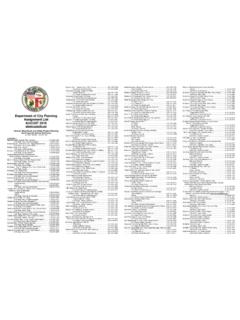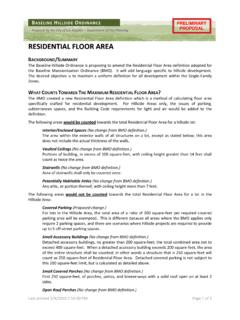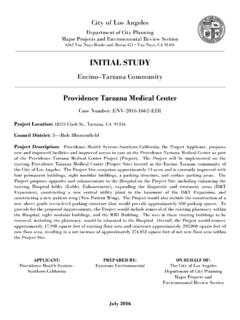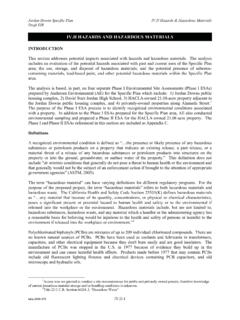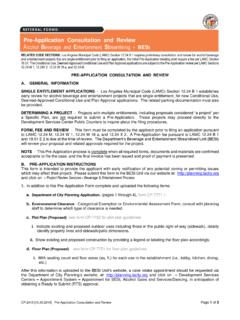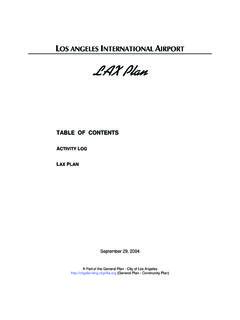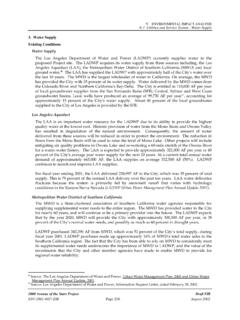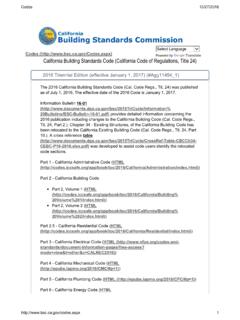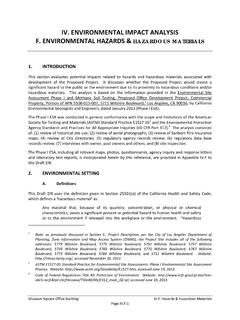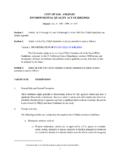Transcription of COMPLETE - Los Angeles City Planning
1 DESIGN GUIDEG reat Streets for Los AngelesCITY OF LOS ANGELESCOMPLETESTREETSTHIS PAGE IS INTENTIONALLY LEFT BLANKC omplete Streets Design GuideACTIVITY LOGS treet Standards Commitee AmendmentsDateAmendmentIIIC omplete Streets Design Guide ACTIVITY LOGDateAmendmentIV ACTIVITY LOG COMPLETE Streets Design GuideTHIS PAGE IS INTENTIONALLY LEFT BLANKV COMPLETE Streets Design Guide 1. INTRODUCTION3 Goals of the Guide 3 COMPLETE Streets Design 4 Applicability 4 Design Immunity 5 Guide Organization 5 Glossary 6 Definitions 7 Right-of-Way Zones and Sample Uses 102.
2 STREET CLASSIFICATIONS .. 15 Introduction 15 Network Overlays 16 Additional Overlays 17 Arterial Streets 18 Non-Arterial Streets 22 Hillside Streets 25 Service Road 27 Other Public Rights-of-Way 293. COMPLETE STREET DIAGRAMS .. 35 Introduction 35 COMPLETE Street Cross Sections 35 COMPLETE Street Sample Plan Views 514. SIDEWALK AREA .. 57 Introduction 574 1 Building Entries 584 2 Portable Signage and Sidewalk Merchandising 604 3 Streetscape Signage and wayfinding 624 4 Public Seating 654 5 Outdoor Dining 684 6 Public Art 714 7 Street Trees and Landscaping 734 8 Stormwater Treatment and Management 784 9 Bicycle Parking 874 1 0 Bikeshare Stations 914 1 1 Parking Meters and Pay Stations 934 1 2 Utilities and other infrastructure 954 1 3 Street Lighting
3 974 1 4 Waste and Recycling Receptacles 1014 15 Parklets 1044 1 6 Bus Stop Location 1074 17 Bus Bulb 1094 1 8 Sidewalk Equestrian Trails 1114 1 9 Esplanade 1135. ROADWAYS ..117 Introduction 1175 1 Pedestrian Plaza 1185 2 Bicycle Lane 1205 3 Protected Bicycle Lane 1275 4 Shared Lane Marking (Sharrow) 1315 5 Bicycle Corral 1335 6 Shared Bicycle-Bus Lane 1355 7 Peak-hour Bus Lane 1365 8 Offset Bus Lane 1385 9 Median Bus Lane / Busway 1395 1 0 Bus Pad 1415 1 1 Median Bus Boarding Island 1425 1 2 Lane Reconfiguration / Road Diet 1445 1 3 Lane Narrowing 1465 14 Neckdown 1475 15 Chicane 1485 1 6 Landscaped Median 1505 17 Speed Feedback Sign 1525 1 8 On-Street
4 Carshare Parking 1535 1 9 Back-In Angle Parking 1545 20 Commercial Loading 156 Table of Contents VI COMPLETE Streets Design Guide6. INTERSECTIONS AND CROSSINGS .. 161 Introduction 1616 1 Crosswalk Markings 1626 2 Decorative Pavement Materials 1656 3 Advance Yield Markings 1666 4 Raised Crosswalk 1676 5 Corner Bulbout 1696 6 Curb Radius 1716 7 Curb Ramp 1746 8 Crossing Refuge Island 1766 9 Driveways 1786 10 Bicycle Pavement Markings approaching an Intersection 1806 1 1 Bicycle Pavement Markings through an Intersection 1836 12 Bicycle
5 Box 1856 13 Two-Stage Turn Queue Box 1876 1 4 Bicycle-Only Left Turn Pocket 1896 15 Diverter 1906 16 Traffic Mini-Circle 1926 17 Mini-Roundabout 1956 18 Exclusive Pedestrian Phase 1986 1 9 Pedestrian Beacon 2006 20 Leading Pedestrian Interval 2026 21 Accessible Pedestrian Signal 2046 22 Shorter Signal Cycle Length 2056 23 Split Phasing 2076 24 Bicycle-Only Signal 2096 25 Bicycle Loop Detector 2116 26 Bicycle Green Wave 2136 27 Transit Signal Prioritization 2157.
6 OFF-STREET NON-VEHICULAR TREATMENTSAND STRATEGIES .. 219 Introduction 2197 1 Bicycle Channel Ramps for Stairways 2207 2 Multi-Purpose Paths (Class I) 2227 3 Multi-Purpose Paths in River and Utility Corridors 2297 4 Multi-Purpose Paths in Existing Active Rail Corridor 2317 5 Multi-Purpose Path Constructed within New Transit Corridor 2337 6 Coastal Paths 2347 7 Grade-Separated Undercrossings and Overcrossings 2367 8 Fencing for Bike Paths 2397 9 Programming and Temporary Treatments 241 THIS PAGE IS INTENTIONALLY LEFT BLANK1 INTRODUCTIONCOMPLETE STREETS DESIGN GUIDETHIS PAGE IS INTENTIONALLY LEFT BLANK3 COMPLETE Streets Design Guide 1.
7 INTRODUCTION1. INTRODUCTIONG oals of the GuideGreat Streets for Los Angeles : COMPLETE Streets Design Guide lays out a vision for designing safe, accessible and vibrant streets in Los Angeles As outlined in California s COMPLETE Streets Act of 2008 (AB 1358), the goal of COMPLETE Streets is to ensure that the safety, accessibility, and convenience of all transportation users pedestrians, bicyclists, transit riders, and motorists is accommodated Streets not only influence our mobility choices, but they also affect the safety and quality of life in our neighborhoods When streets are designed with only vehicular throughput in mind, they create an environment that invites unsafe speeds As a result, bicycling becomes more daunting and pedestrian walkways become less enjoyable An overabundance of single-occupancy vehicles on the road slows down buses and other motorists, making public transit less convenient and driving more frustrating When streets are continually widened to accommodate more vehicular volume.
8 They create an induced demand for car travel that only encourages future traffic congestion Los Angeles streets serve a much larger purpose than just moving cars They can provide lively gathering places that foster community building and neighborhood identity COMPLETE Streets encourage healthy recreational activities such as walking, running, and bicycling, and they can boost the economic activity and visibility of storefront businesses When cars travel at slower, safer speeds, the number of collisions between motorists and active transportation users decreases Moreover, fewer cars on the road means lower levels of air pollution Overall, a city that is designed for COMPLETE Streets prioritizes people over cars, and safety over speed The COMPLETE Streets Design Guide provides a compilation of design concepts and best practices that promote the major tenets of COMPLETE Streets safety and accessibility The Guide is meant to supplement existing engineering practices and requirements in order to meet the goals of COMPLETE Streets Due to specific site and operational characteristics associated with any given street, any proposed street improvement project must still undergo a detailed technical analysis by the appropriate city departments Specific design guidance that is in a demonstration phase and has yet to be incorporated into the California Manual on Uniform Traffic Control Devices (CA MUTCD) 4 1.
9 INTRODUCTIONC omplete Streets Design Guidewill require provisional approval from the appropriate City departments Overall, the COMPLETE Streets Design Guide seeks to establish the concept of COMPLETE Streets into Los Angeles present and future street design so that all stakeholders are able to plan for, implement, and maintain safe and accessible streets for all users The COMPLETE Streets Design Guide accompanies Mobility Plan 2035, an important update to the Mobility Element (formerly Transportation Element) of the City of Los Angeles General Plan Mobility Plan 2035 s five goals Safety First, World Class Infrastructure, Access for all Angelenos, Informed Choices, and Clean Environments for a Healthy Community set the policy foundation making COMPLETE Streets a priority in Los Angeles The Plan s emphasis on safety, traffic calming and access are key principles that mirror the goals of the COMPLETE Streets Design Guide The COMPLETE Streets Design Guide is a living document, meaning that it will be amended as best practices and innovations in street design continue to evolve The Guide falls under the authority of the City of Los Angeles Streets Standards Committee, which is composed of the Director of City Planning (Chairman), General Manager of the Department of Transportation, and the City Engineer (LAMC 17 05)
10 COMPLETE Streets Design Designing is not a one-size-fits-all approach It requires an analysis of various site conditions to determine what sort of treatments and solutions are applicable for a given street Factors that should be considered include the physical characteristics of the street, urban vs suburban context, surrounding land uses, collision history, and expected pedestrian and roadway demand Treatments can vary from installing physical infrastructure, to altering signalization, or to simply reinforcing safety efforts with signage Funding is also a major determinant of what types of treatments are feasible for certain projects ApplicabilityThe COMPLETE Streets Design Guide is intended to serve a variety of users For City departments that oversee the implementation of street improvement projects, the Guide serves as a guiding document that ensures all projects are designed with COMPLETE Street principles in mind Private developers can also use the Guide to tailor their projects to support COMPLETE Street principles Elected officials can consult the Guide when proposing public improvements in their jurisdictions, while communities and local groups can refer to the Guide when advocating for safety treatments in their neighborhoods 5 COMPLETE Streets Design Guide 1.
